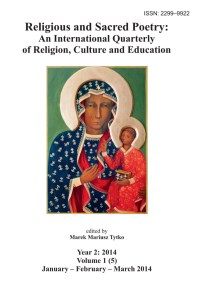Twórczość Macieja Kazimierza Sarbiewskiego i jej recepcja w dawnych ukraińskich poetykach XVII-XVIII w.
Maciej Kazimierz Sarbiewski’s Work and Its Reception in Old Ukrainian Poetics in the Seventeenth and Eighteenth Centuries
Author(s): Oleksandr Grigorovich AstafievPublished by: Fundacja Naukowa Katolików »Eschaton«
Keywords: Maciej Kazimierz Sarbiewski (1595-1640); Matthias Casimirus Sarbievius (1595- 1640); Motiejus Kazimieras Sarbievijus (1595-1640); Casimir Britannicus (1595- 1640); Mathias Casimirus Sarbiewski (1595-1640); Sarbievius (1595-1640); Casimir (1595-1640)
Summary/Abstract: The aim of the article was to study the work of Maciej Kazimierz (Mathew Casimir) Sarbiewski as a representation of a link in the aesthetic and artistic development of the thought and culture in the 17th c. and at the beginning of the 18th in the eastern part of the former Polish –Lithuanian Commonwealth i.e. on the territory of the present-day Ukraine, with reference to baroque as a style in art and a method of classical poetics. The author applied: 1) a method of biographical analysis ( interpreting the texts in order to point to their origin in the factography and biography of their author); 2) an analysis of the historical documents (a historiographic method of analyzing documents); 3) Paul de Man`s method of comparative analysis, which provided the main methodological basis in this study. Main results of the analysis. Sarbiewski created his metaphors as images following the principles of the baroque conceptism and its features such as: a wit, accuracy, sharpness (conceptus, acumen, acutum, argutiae, argutum). He also applied artistic metaphors, unexpected comparisons, impressive antitheses. Having analysed the borrowings from J. Pontana and J.C. Scaliger in Sarbiewski’s works, the author of the article concludes that in Sarbiewski’s heritage you can find modification of Renaissance works, some traces of neo- scholastic and baroque synthesis, but the classical elements are joined with the Renaissance ones, specially the concept of artist/painter as god the creator. The article also draws the reader`s attention to some elements of the reception of Sarbiewski’s work by the authors of the books of poetics coming from the eastern territories of the Polish-Lithuanian Commonwealth. The results of the analyses are limited to the rhetorical arrangement of the text, including artistic devices such as, for instance, hyperbolization of the literary language. The text is a contribution to further studies upon the influence of Sarbiewski’s thought in Eastern Europe. The article does not address Sarbiewski`s philosophical questions as, in fact, they remain beyond the area of research of the author. Looked at from a practical point of view, the research results can be used for didactic processes, for preparing normative and specialized courses, for creating teaching materials and manuals of Polish literary history, particularly with reference to the literature of the Polish-Ukrainian borderland. The novelty of the research consists in the fact that it is the first attempt to examine the reception of Sarbiewski’s work in the so-called Old Ukrainian (Old Russian) poetics of the 17 and 18th c. It establishes general and basic categories of the discussion on rhetoric and recognizes their mutual relations. By establishing the scope and sphere of the ideas discussed, it helps to identify the examined phenomenon.
Journal: Religious and Sacred Poetry: An International Quarterly of Religion, Culture and Education
- Issue Year: 2014
- Issue No: 1
- Page Range: 79-118
- Page Count: 40

